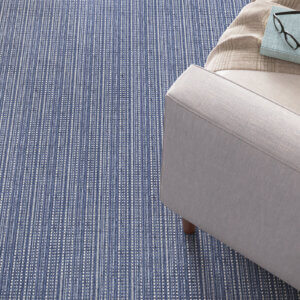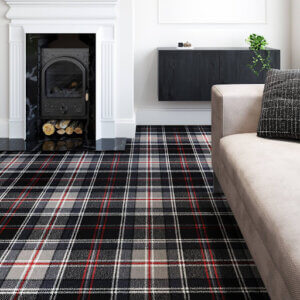Woven Words
How To Get A New Rug To Lay Flat: Top 15 Expert Tips!

How To Get A New Rug To Lay Flat: Top 15 Expert Tips!
Getting a new rug to lay flat can seem like a challenge, especially if you’re not sure which tips and techniques to use. But don’t worry – with the right advice from Bloomsburg Carpet, you can ensure that your rug looks smooth and well-placed in your home! Here, we’ll share our 15 top tips to help you get a new rug to lay flat. So keep reading to learn how to get a new rug to lay flat in no time!
Unroll The Rug Properly
Unrolling the rug properly is one of the most important steps in getting a new rug to lay flat. Taking extra care to lay it out exactly how you want it is key to avoiding creases and wrinkles. If your rug has been rolled up for an extended period of time, you should let it sit unrolled for at least 24 hours before attempting to place it in its final location. This will give the rug time to adjust and become flexible, allowing you to move and adjust it easily until everything looks perfect.
If your rug was shipped rolled up, you should make sure that all of the excess material is removed before unrolling so that nothing gets bunched up or tangled when you attempt to flatten the rug. Once you have the rug removed from its packaging, take extra care not to use anything sharp or abrasive on the material. Most rugs are tucked into plastic wrapping and can easily be cut if not handled carefully. If possible, use gloves or a cloth to protect the material when unrolling it.
Lay It In A Flat Area
When laying out your rug, it’s important to select a flat area in which to do so. Uneven surfaces may cause the rug to warp or bunch up over time, leading to an unsightly finish. Ideal areas for rug placement include living rooms, bedrooms, or other low-traffic spaces with plenty of space and an even surface. It is also important to consider the amount of direct sunlight that will hit the rug in its chosen spot, as too much can lead to fading or discoloration. If possible, try to avoid high-traffic areas such as entryways, as this could result in quicker wear and tear on the fabric.
Check For Any Imperfections
Once you have unrolled the rug, it’s important to take a moment to inspect the fabric for any imperfections or defects. Look for loose threads, tears, or color discrepancies that may be present. If you notice any issues, it’s best to determine whether they can easily be resolved yourself or if the rug should be returned and exchanged for another one. Minor issues can often be addressed with careful stitching and some minor repairs. However, in cases where larger sections are affected or the entire rug is damaged, it’s best to return it and exchange it for a more suitable piece.
Use Heavy Furniture
When placing a rug in a room, it’s important to take a few extra steps to ensure it lays flat. To achieve this, you can use heavy furniture, such as couches or bookshelves, to anchor the edges of the rug and prevent them from curling up. This technique is especially effective for thick rugs with a lot of weight. It’s important to be mindful of the weight of the furniture you decide to use; if it’s too heavy, it could potentially damage the rug over time. Additionally, opt for heavier pieces that won’t easily move around when people walk on the rug. If you have any other heavy items like desks or tables in the room, these can also be used as long as they are placed securely on either side of the rug.
Rug Grippers Or Pads
Rug grippers or pads are a great way to keep rugs in place and prevent them from shifting, which can result in bumps and curled edges. They also help to create a flat and even surface for the rug, making it look better and last longer. Rug grippers or pads come in a variety of materials and sizes, so they’re suitable for most floor types, including wood, tile, laminate, carpeting, vinyl, concrete, and more.
For installation instructions, make sure to purchase rug grippers or pads that match the size of your rug or are slightly larger. Place the rug on the desired spot on the floor and then attach the grippers to each corner of the rug. This will ensure that it won’t slide around when walked on. If you’re using a pad instead of a gripper, place it underneath the rug before attaching the corners with clips or tape. Be sure to measure both your rug and floor correctly to ensure you purchase a pad or gripper of an appropriate size.
Roll It In The Opposite Direction
After the rug is in place, it might have a couple of creases or curls that need to be addressed. To do so, just roll the rug in the opposite direction as it was laid out for a few minutes. This will help to relax any fibers that have been stretched out during the initial installation process. Make sure to be gentle when rolling it up and back out again; otherwise, you could cause damage to the fabric or fibers.
Once you’ve spent enough time rolling it in the opposite direction, unroll it again. If there are still some creases present, go ahead and roll it one more time in the opposite direction for an extra minute. This should help reduce any remaining wrinkles or folds before you leave your new rug alone!
Apply Rug Tape
To help keep your rug flat, you can apply a type of rug tape along the edges to limit any shifting or curling. Rug tape is designed to adhere well to both the rug and the flooring without causing any damage, so make sure to use a residue-free tape.
The application process is simple: start at one corner of the rug and slowly lay down strips of tape as you make your way around it. Make sure to leave a few inches between each strip, as it will allow for more even distribution when the rug shifts. Once all four edges have been taped, go over them with a roller or heavy object; this will help push down firmly and stick the tape much better than just pressing on it with your fingers alone.
Finally, trim off any excess or overlapping pieces of tape with scissors or a sharp knife blade. This step is important because any overlapping edges can cause the adhesive to stick to itself, which could lead to an uneven look or more wrinkles over time.
Steam The Rug
Steamers are a great way to help remove wrinkles from your rug and keep it looking its best. Before using a steamer, be sure to read and follow the instruction manual that came with your machine. It is also recommended to test the steamer on a small part of the rug first, just to make sure it does not cause any damage or discoloration.
It is recommended to give your rug a steam clean at least once every six months in order to keep it looking its best. Doing this regularly will help get rid of germs and bacteria that can accumulate over time, ensuring your rug stays in good condition.
Iron With A Damp Cloth
Using a damp cloth and iron is an effective way to flatten the rug fibers and create a more even surface. It’s important to use a low or medium heat setting when using the iron, as high temperatures can damage the fibers of the rug. Make sure that the damp cloth is completely covering the area of the rug you are going to press with the iron. This will protect it from direct contact with the hot metal of the iron.
Safety precautions should also be taken when using this technique; it’s best to wear protective gloves while handling an iron in order to avoid burns. Additionally, take care not to leave any part of your rug exposed for too long, as higher temperatures can cause discoloration and damage over time.
Expose It To Sunlight
Sunlight is a great way to relax the fibers of your rug and reduce wrinkles in the fabric. By exposing it to direct sunlight, you can help maintain its shape and texture for many years. However, it’s important to be mindful of the duration and frequency of sunlight exposure, as too much exposure can cause fading or damage. If done correctly, you can safely expose your rug to the sun while gaining its benefits; just make sure that you limit the exposure time and do not leave it out for too long. Aim for no more than 30 minutes a day—spread over multiple sessions if possible—and try to avoid long stretches of consecutive days in the sun. With this approach, you can keep your rug looking beautiful and wrinkle-free without risking any discoloration or other damage.
Humidity Control
Since humidity levels can significantly affect the flatness of a rug, it’s important to control them in order to keep your rug looking its best. High humidity can cause buckling and wrinkling, while low humidity can cause fibers to dry out and crack or fray. You can use a dehumidifier or a humidifier, depending on the season. If you have an air conditioner installed, you should also make sure that it’s working properly and that the filters are regularly replaced.
It’s also important to take steps to avoid excess moisture in the room from other sources. Make sure that you regularly clean up any spills so mold or mildew don’t form. You should also look for leaks or standing water around windows and door frames, as these can contribute to higher humidity levels. Finally, limit showering near your rug if possible, as steam from hot showers is one of the main culprits for high moisture in the area.
Roll And Wait
The roll-and-wait technique is a great way to help your rug naturally flatten over time. This method involves putting heavy objects like books or cans on the edges of the rug for several hours, then rolling up the rug and leaving it in that position for a few days. Doing this a few times over the course of a couple of weeks allows gravity to pull out any bumps or lumps in the carpet fibers and help them settle more evenly. This can be combined with regular vacuuming to further speed up the process. It’s recommended that you use the roll-and-wait technique for at least one to two weeks if you want to achieve maximum results.
Beat And Shake
The beat and shake method is another way to help keep your rug in good condition over time. This technique involves gently beating the rug with a broom handle or similar implement to remove dust, dirt, and wrinkles. Be sure to perform this task outdoors, as it can create a lot of dust that may be difficult to clean up indoors. When performing the beat and shake technique, make sure you have sufficient space around you and that you are wearing protective gear. Start from one end of the rug and hit it rhythmically with the broom handle while slowly walking along its length. Be gentle but firm, since too much force can damage the fibers. Once done, take the rug outside for a vigorous shaking session. Make sure no one is standing near you when doing so, as the dust will fly everywhere! This process can be repeated every few weeks to ensure your rug remains in tip-top condition.
Regular Vacuuming
Regular vacuuming is essential for maintaining rug flatness and preventing dirt from settling deep within the fibers. Rigorous vacuuming with powerful suction can help pull out stuck-in dust and dirt, so it’s important to use the right vacuum cleaner with appropriate attachments (a beater brush or powered hand tool) to clean your rug effectively. Vacuum cleaning should be done in an overlapping pattern, going over each area multiple times to ensure thorough cleaning. Depending on the usage of the rug, vacuuming should be done at least once a week for high-traffic areas or every two weeks for normal-traffic areas. This is especially true for rugs located in busy hallways or living rooms, which should be vacuumed daily if possible.
Proper Storage
Rug storage is also an important factor in maintaining its longevity. When not in use, it’s best to roll the rug up and store it in a dry, well-ventilated area. This will help maintain its flatness and ensure that the rug doesn’t become misshapen or lumpy due to gravity or over time. It is also important to avoid storing the rug in any area where moisture or pests can be a problem. Any kind of dampness has the potential to cause mold and mildew buildup, while rodents and insects can wreak havoc on fibers, ruining the rug altogether.
Seek Professional Help
For more difficult rug-flattening tasks, it is often best to seek professional help. Rug cleaners and restorers are trained in the proper techniques for restoring a rug’s original shape and structure. These professionals can also apply treatments that may be necessary depending on the rug’s material, such as steam cleaning, hand washing, or dry cleaning. It’s important to take the time to find a reputable professional who is knowledgeable about restoring rugs so that you can ensure your piece will be handled properly and professionally. It’s also important to do some research into what treatments will be most effective for your specific rug or piece. With the right professional help, your treasured rug can look as good as new!
Enhance Your Home Decor With Custom Rugs By Bloomsburg Carpet!
With Bloomsburg Carpet, you can buy custom rugs in a variety of styles and colors to perfectly match your room’s decor. Quickly and easily browse our collection of rugs in every size, shape, style and fabric imaginable. Whether you’re looking for a unique piece or something classic, our vast selection is sure to contain the perfect flat rug for your home! Shop with us today and get the best quality and value that Bloomsburg Carpet offers. Our team is standing by to help you find the perfect rug for every room in your home. Get started today and be sure to check out our amazing selection of colors and styles!


